|
LANDING ON
PLANET EARTH
WE HAVE SET FOOT only on the Moon, and have probed only the planets
closest to us with unmanned craft.
Beyond our relatively close
neighbors, both interplanetary and outer space are still outside the
reach of even small
scanning craft. But the Nefilim's own planet, with its vast orbit,
has served as a traveling observatory, taking them
through the orbits of all the outer planets and enabling them to
observe at first hand most of the solar system.
No wonder, then, that when they landed on Earth, a good deal of the
knowledge they brought with them concerned astronomy and celestial
mathematics. The Nefilim, "Gods of Heaven" upon Earth, taught Man to
look up unto the heavens - just as Yahweh urged Abraham to do.
No wonder, too, that even the earliest and crudest sculptures and
drawings bore celestial symbols of constellations and planets; and
that when the gods were to be represented or invoked, their
celestial symbols were used as a graphic shorthand. By invoking the
celestial ("divine") symbols, Man was no longer alone; the symbols
connected Earthlings with the Nefilim, Earth with Heaven, Mankind
with the universe.
Some of the symbols, we believe, also convey information that could
be related only to space travel to Earth.
Ancient sources provide a profusion of texts and lists I dealing
with the celestial bodies and their associations with the various
deities. The ancient habit of assigning I several epithet names to
both the celestial bodies and the I deities has made identification
difficult. Even in the case of established identifications, such as
Venus/Ishtar, the picture is confused by the changes in the
pantheon. Thus, in earlier times Venus was associated with Ninhursag.
Somewhat greater clarity has been obtained by scholars, such as E.
D. Van Buren (Symbols of the Gods in Mesopotamian Art), who
assembled and sorted out the more than eighty symbols - of gods and
celestial bodies - that can be found on cylinder seals, sculptures, stelae, reliefs, murals, and (in great detail and clarity) on
boundary stones (kudurru in Akkadian).
When the classification of
the symbols is made, it becomes evident that apart from standing for
some of the better-known southern or northern constellations (such
as the Sea Serpent for the constellation Hydra), they represented
either the twelve constellations of the zodiac (for example, the
Crab for Scorpio), or the twelve Gods of Heaven and Earth, or the
twelve members of the solar system. The kudurru set up by Melishipak,
king of Susa, shows the twelve symbols of the zodiac and the symbols
of the twelve astral gods.
A stela erected by the Assyrian king Esarhaddon shows the ruler
holding the Cup of Life while facing the twelve chief Gods of Heaven
and Earth. We see four gods atop animals, of whom Ishtar on the lion
and Adad holding the forked lightning can definitely be identified.
Four other gods are represented by the tools of their special
attributes, as the war-god Ninurta by his lion-headed mace.
The
remaining four gods are shown as celestial bodies - the Sun
(Shamash), the Winged Globe (the Twelfth Planet, the abode of Anu),
the Moon's crescent, and a symbol consisting of seven dots.
Although in later times the god Sin was associated with the Moon,
identified by the crescent, ample evidence shows that in "olden
times" the crescent was the symbol of an elderly and bearded deity,
one of Sumer's true "olden gods." Often shown surrounded by streams
of water, this god was undoubtedly Ea.
The crescent was also
associated with the science of measuring and calculating, of which
Ea was the divine master. It was appropriate that the God of the
Seas and Oceans, Ea, be assigned as his celestial counterpart the
Moon, which causes the ocean's tides.
What was the meaning of the symbol of the seven dots?
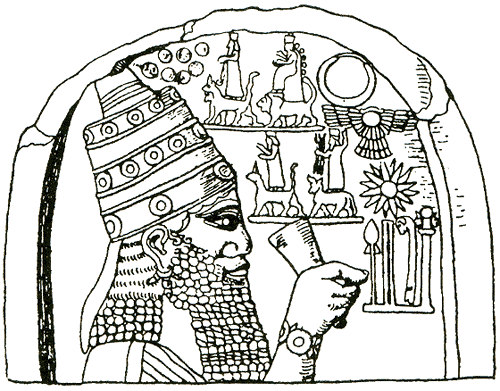
Many clues leave no doubt that it was the celestial symbol of Enlil.
The depiction of the Gateway of Anu (the Winged Globe) flanked by Ea
and Enlil, represents them by the crescent and the seven-dot symbol.
Some of the clearest depictions of the celestial symbols that were
meticulously copied by Sir Henry Rawlinson (The Cuneiform
Inscriptions of Western Asia) assign the most prominent position to
a group of three symbols, standing for Anu flanked by his two sons;
these show that the symbol for Enlil could be either the seven dots
or a seven-pointed "star."
The essential element in Enlil's
celestial representation was the number seven (the daughter,
Ninhursag, was sometimes included, represented by the umbilical
cutter).

Scholars have been unable to understand a statement by Gudea, king
of Lagash, that "the celestial 7 is 50."
Attempts at arithmetic
solutions - some formula whereby the number seven would go into
fifty - failed to reveal the meaning of the statement. However, we
see a simple answer: Gudea stated that the celestial body that is
"seven" stands for the god that is "fifty." The god Enlil, whose
rank number was fifty, had as his celestial counterpart the planet
that was seventh.
Which planet was the planet of Enlil? We recall the texts that speak
of the early times when the gods first came to Earth, when Anu
stayed on the Twelfth Planet, and his two sons who had gone down to
Earth drew lots. Ea was given the "rulership over the Deep," and to
Enlil "the Earth was given for his dominion." And the answer to the
puzzle bursts out in all its significance:
The planet of Enlil was Earth. Earth - to the Nefilim - was the
seventh planet.
In February 1971, the United States launched an unmanned spacecraft
on the longest mission to date. For twenty-one months it traveled,
past Mars and the asteroid belt, to a precisely scheduled rendezvous
with Jupiter. Then, as anticipated by NASA scientists, the immense
gravitational pull of Jupiter "grabbed" the spacecraft and hurled it
into outer space.
Speculating that Pioneer 10 might someday be attracted by the
gravitational pull of another "solar system" and crash-land on some
planet elsewhere in the universe, the Pioneer 10 scientists attached
to it an engraved aluminum plaque bearing the accompanying
"message."
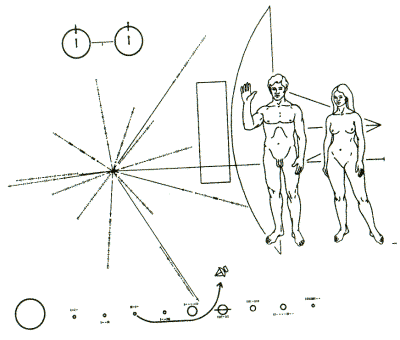
The message employs a pictographic language - signs and symbols not
too different from those used in the very first pictographic writing
of Sumer. It attempts to tell whoever might find the plaque that
Mankind is male and
female, of a size related to the size and shape of the spacecraft.
It depicts the two basic chemical elements of our world, and our
location relative to a certain interstellar source of radio
emissions.
And it depicts our solar system as a Sun and nine
planets, telling the finder:
"The craft that you have found comes
from the third planet of this Sun."
Our astronomy is geared to the notion that Earth is the third planet
- which, indeed, it is if one begins the count from the center 6f
our system, the Sun.
But to someone nearing our solar system from the outside, the first
planet to be encountered would be Pluto, the second Neptune, the
third Uranus - not Earth. Fourth would be Saturn; fifth, Jupiter;
sixth, Mars.
And Earth would be seventh.
No one but the Nefilim, traveling to Earth past Pluto, Neptune,
Uranus, Saturn, Jupiter, and Mars, could have considered Earth "the
seventh." Even if, for the sake of argument, one assumed that the
inhabitants of ancient Mesopotamia, rather than travelers from
space, had the knowledge or wisdom to count Earth's position not
from the central Sun but from the solar system's edge, then it would
follow that the ancient peoples knew of the existence of Pluto and
Neptune and Uranus. Since they could not have known of these
outermost planets on their own, the information must, we conclude,
have been imparted to them by the Nefilim.
Whichever assumption is adopted as a starting point, the conclusion
is the same: Only the Nefilim could have known that there are
planets beyond Saturn, as a consequence of which Earth - counting
from the outside - is the seventh.
Earth is not the only planet whose numerical position in the solar
system was represented symbolically. Ample evidence shows that Venus
was depicted as an eight-pointed star: Venus is the eighth planet,
following Earth, when counted from the outside.
The eight-pointed
star also stood for the goddess Ishtar, whose planet was Venus.
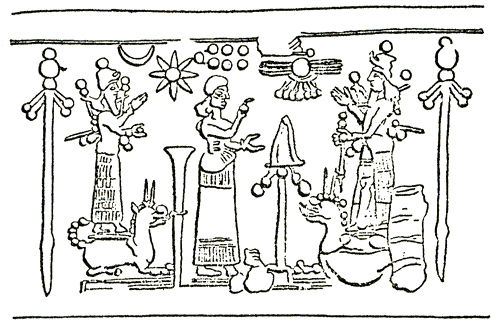
Many cylinder seals and other graphic relics depict Mars as the
sixth planet.
A cylinder seal shows the god associated with Mars
(originally Nergal, then Nabu), seated on a throne under a
six-pointed "star" as his symbol.
Other symbols on the seal show the
Sun, much in the same manner we would depict it today; the Moon; and
the cross, symbol of the "Planet of Crossing," the Twelfth Planet.
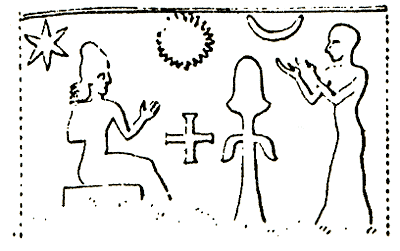
In Assyrian times, the "celestial count" of a god's planet was often
indicated by the appropriate number of star symbols placed alongside
the god's throne.
Thus, a plaque depicting the god Ninurta placed
four star symbols at his throne. His planet Saturn is indeed the
fourth planet, as counted by the Nefilim. Similar depictions have
been found for most of the other planets.
The central religious event of ancient Mesopotamia, the twelve-day
New Year Festival, was replete with symbolism that had to do with
the orbit of the Twelfth Planet, the makeup of the solar system, and
the journey of the Nefilim to Earth. The best-documented of these
"affirmations of the faith" were the Babylonian New Year rituals;
but evidence shows that the Babylonians only copied traditions going
back to the beginning of Sumerian civilization.
In Babylon, the festival followed a very strict and detailed ritual;
each portion, act, and prayer had a traditional
reason and a specific meaning. The ceremonies started on the first
day of Nisan - then the first month of the year - coinciding with
the spring equinox.
For eleven days, the other gods with a celestial
status joined Marduk in a prescribed order. On the twelfth day, each
of the other gods departed to his own abode, and Marduk was left
alone in his splendor.
The parallel to the appearance of Marduk
within the planetary system, his "visit" with the eleven other
members of the solar system, and the separation on the twelfth day -
leaving the Twelfth God to go on as King of the Gods, but in
isolation from them - is obvious.
The ceremonies of the New Year Festival paralleled the course of the
Twelfth Planet. The first four days, matching Marduk's passage by
the first four planets (Pluto, Neptune, Uranus, and Saturn), were
days of preparation. At the end of the fourth day, the rituals
called for marking the appearance of the planet Iku (Jupiter) within
sight of Marduk. The celestial Marduk was nearing the place of the
celestial battle; symbolically, the high priest began reciting the
"Epic of Creation" - the tale of that celestial battle.
The night passed without sleep. When the tale of the celestial
battle had been recited, and as the fifth day was breaking, the
rituals called for the twelvefold proclamation of Marduk as "The
Lord," affirming that in the aftermath of the celestial battle there
were now twelve members of the solar system. The recitations then
named the twelve members of the solar system and the twelve
constellations of the zodiac.
Sometime during the fifth day, the god Nabu - Marduk's son and heir
- arrived by boat from his cult center, Borsippa. But he entered
Babylon's temple compound only on the sixth day, for by then Nabu
was a member of the Babylonian pantheon of twelve and the planet
assigned to him was Mars - the sixth planet.
The Book of Genesis informs us that in six days "the Heaven and the
Earth and all their host" were completed. The Babylonian rituals
commemorating the celestial events that resulted in the creation of
the asteroid belt and Earth were also completed in the first six
days of Nisan.
On the seventh day, the festival turned its attention to Earth.
Though details of the rituals on the seventh day are
scarce, H. Frankfort (Kingship and the Gods) believes that they
involved an enactment by the gods, led by Nabu, of the liberation of
Marduk from his imprisonment in the "Mountains of Lower Earth."
Since texts have been found that detail epic struggles between Marduk and other claimants to the rulership of Earth, we can surmise
that the events of the seventh day were a reenactment of Marduk's
struggle for supremacy on Earth (the "Seventh"), his initial
defeats, and his final victory and usurpation of the powers.
On the eighth day of the New Year Festival in Babylon, Marduk,
victorious on Earth, as the forged Enuma Elish had made him in the
heavens, received the supreme powers. Having bestowed them on Marduk,
the gods, assisted by the king and populace, then embarked, on the
ninth day, on a ritual procession that took Marduk from his house
within the city's sacred precinct to the "House of Akitu," somewhere
outside the city.
Marduk and the visiting eleven gods stayed there
through the eleventh day; on the twelfth day, the gods dispersed to
their various abodes, and the festival was over.
Of the many aspects of the Babylonian festival that reveal its
earlier, Sumerian origins, one of the most significant was that
which pertained to the House of Akitu. Several studies, such as The
Babylonian Akitu Festival by S. A. Pallis, have established that
this house was featured in religious ceremonies in Sumer as early as
the third millennium B.C.
The essence of the ceremony was a holy /
procession that saw the reigning god leave his abode or/ temple and
go, via several stations, to a place well out JOT town. A special
ship, a "Divine Boat," was used for the purpose. Then the god,
successful in whatever his mission was at the A.KI.TI House,
returned to the city's quay by the same Divine Boat, and retraced
his course back to the temple amid feasting and rejoicing by the
king and populace.
The Sumerian term A.KI.TI (from which the Babylonian akttu derived)
literally meant "build on Earth life."
This, coupled with the
various aspects of the mysterious journey, leads us to conclude that
the procession symbolized the hazardous but successful voyage of the Nefilim from their abode to the seventh planet, Earth.
Excavations conducted over some twenty years on the site of ancient
Babylon, brilliantly correlated with Babylonian ritual texts,
enabled teams of scholars led by F. Wetzel and F. H. Weissbach (Das
Hauptheiligtum des Marduks in Babylon) to reconstruct the holy
precinct of Marduk, the architectural features of his ziggurat, and
the Processional Way, portions of which were reerected at the Museum
of the Ancient Near East, in East Berlin.
The symbolic names of the seven stations and the epithet of Marduk
at each station were given in both Akkadian and Sumerian - attesting
both to the antiquity and to the Sumerian origins of the procession
and its symbolism.
The first station of Marduk, at which his epithet was "Ruler of the
Heavens," was named "House of Holiness" in Akkadian and "House of
Bright Waters" in Sumerian. The god's epithet at the second station
is illegible; the station itself was named "Where the Field
Separates."
The partly mutilated name of the third station began
with the words "Location facing the planet . . ."; and the god's
epithet there changed to "Lord of Poured-Out Fire."
The fourth station was called "Holy Place of Destinies," and Marduk
was called "Lord of the Storm of the Waters of An and Ki." The fifth
station appeared less turbulent. It was named "The Roadway," and
Marduk assumed the title "Where the Shepherd's Word Appears."
Smoother sailing was also indicated at the sixth station, called
"The Traveler's Ship," where Marduk's epithet changed to "God of the
Marked-Out Gateway."
The seventh station was the Bit Akitu ("house of building life on
Earth"). There, Marduk took the title "God of the House of Resting."
It is our contention that the seven stations in the procession of
Marduk represented the space trip of the Nefilim from their planet
to Earth; that the first "station," the "House of Bright Waters,"
represented the passage by Pluto; the second ("Where the Field
Separates") was Neptune; the third, Uranus; the fourth - a place of
celestial storms - Saturn. The fifth, where "The Roadway" became
clear, "where the shepherd's word appears," was Jupiter.
The sixth,
where the journey switched to "The Traveler's Ship," was Mars,
And the seventh station was Earth - the end of the journey, where
Marduk provided the "House of Resting" (the god's "house of building
life on Earth").
How did the "Aeronautics and Space Administration"
of the Nefilim view the solar system in terms of the space flight to
Earth?
Logically - and in fact - they viewed the system in two parts. The
one zone of concern was the zone of flight, which embraced the space
occupied by the seven planets extending from Pluto to Earth. The
second group, beyond the zone of navigation, was made up of four
celestial bodies - the Moon, Venus, Mercury, and the Sun. In
astronomy and divine genealogy, the two groups were considered
separate.
Genealogically, Sin (as the Moon) was the head of the group of the
"Four." Shamash (as the Sun) was his son, and Ishtar (Venus), his
daughter. Adad, as Mercury, was the Uncle, Sin's brother, who always
kept company with his nephew Shamash and (especially) with his niece
Ishtar.
The "Seven," on the other hand, were lumped together in texts
dealing with the affairs of both gods and men, and with celestial
events. They were "the seven who judge," "seven emissaries of Anu,
their king," and it was after them that the number seven was
consecrated.
There were "seven olden cities"; cities had seven
gates; gates had seven bolts; / blessings called for seven years of
plenty; curses, for famines and plagues lasting seven years; divine
weddings were celebrated by "seven days of lovemaking"; and so on
and on.
During solemn ceremonies like those that accompanied the rare visits
to Earth by Anu and his consort, the deities representing the Seven
Planets were assigned certain positions and ceremonial robes, while
the Four were treated as a separate group. For example, ancient
rules of protocol stated: "The deities Adad, Sin, Shamash, and
Ishtar shall be seated in the court until daybreak."
In the skies, each group was supposed to stay in its own celestial
zone, and the Sumerians assumed that there was a "celestial bar"
keeping the two groups apart.
"An important astral-mythological text," according to A. Jeremias
(The Old Testament in the Light of the Ancient Near East), deals
with some remarkable celestial event, when the Seven "stormed in
upon the Celestial Bar."
In this upheaval, which apparently was an
unusual alignment of the Seven Planets,
"they made allies of the
hero Shamash [the Sun] and of the valiant Adad [Mercury]" - meaning,
perhaps, that all exerted a gravitational pull in a single
direction.
"At the same time, Ishtar, seeking a glorious dwelling
place with Anu, strove to become Queen of Heaven" - Venus was
somehow shifting its location to a more "glorious dwelling place."
The greatest effect was on Sin (the Moon).
"The seven who fear not
the laws . . . the Light-giver Sin had violently besieged."
According to this text, the appearance of the Twelfth Planet saved
the darkened Moon and made it "shine forth in the heavens" once
again.
The Four were located in a celestial zone the Sumerians termed
GIR.HE.A ("celestial waters where rockets are confused"), MU.HE
("confusion of spacecraft"), or UL.HE ("band of confusion").
These
puzzling terms make sense once we realize that the Nefilim
considered the heavens of the solar system in terms of their space
travel. Only recently, the engineers of Comsat (Communications
Satellite Corporation) discovered that the Sun and Moon "trick"
satellites and "shut them off." Earth satellites could be "confused"
by showers of particles from solar flares or by changes in the
Moon's reflection of infrared rays. The Nefilim, too, were aware
that rocket ships or spacecraft entered a "zone of confusion" once
they passed Earth and neared Venus, Mercury, and the Sun.
Separated from the Four by an assumed celestial bar, the Seven were
in a celestial zone for which the Sumerians used the term UB. The ub
consisted of seven parts called (in Akkadian) giparu ("night
residences"). There is little doubt that this was the origin of Near
Eastern beliefs in the "Seven heavens."
The seven "orbs" or "spheres" of the ub comprised the Akkadian
kishshatu ("the entirety"). The term's origin was the Sumerian SHU,
which also implied "that part which was the most important," the
Supreme. The Seven Planets
were therefore sometimes called "the Seven Shiny Ones SHU.NU" - the
Seven who "in the Supreme Part rest."
The Seven were treated in greater technical detail than the Four.
Sumerian, Babylonian, and Assyrian celestial lists described them
with various epithets and listed them in their correct order. Most
scholars, assuming that the ancient texts could not possibly have
dealt with planets beyond Saturn, have found it difficult to
identify correctly the planets described in the texts. But our own
findings make identification and understanding of the names'
meanings relatively easy.
First to be encountered by the Nefilim approaching the solar system
was Pluto. The Mesopotamian lists name this planet SHU.PA
("supervisor of the SHU"), the planet that guards the approach to
the Supreme Part of the solar system.
As we shall see, the Nefilim could land on Earth only if their
spaceship were launched from the Twelfth Planet well before reaching
Earth's vicinity, They could thus have crossed the orbit of Pluto
not only as inhabitants of the Twelfth Planet but also as astronauts
in a moving spaceship. An astronomical text said that the planet
Shupa was the one where "the deity Enlil fixed the destiny for the
Land" - where the god, in charge of a spacecraft, set the right
course for the planet Earth and the Land of Sumer.
Next to Shupa was IRU ("loop").
At Neptune, the spacecraft of the Nefilim probably commenced its wide curve or "loop" toward its final
target Another list named the planet HUM.BA, which connotes
"swampland vegetation." When we probe Neptune someday, will we
discover that its persistent association with waters is due to the
watery swamps the Nefilim saw upon it?
Uranus was called Kakkab Shanamma ("planet which is the double").
Uranus is truly the twin of Neptune in size and appearance. A
Sumerian list calls it EN.TI.MASH. SIG ("planet of bright greenish
life"). Is Uranus, too, a planet on which swampy vegetation
abounded?
Beyond Uranus looms Saturn, a giant planet (nearly ten times Earth's
size) distinguished by its rings, which extend more than twice as
far out as the planet's diameter. Armed with a tremendous
gravitational pull and the mysterious rings, Saturn must have posed
many dangers to the Nefilim and their spacecraft. This may well
explain why they called the fourth planet TAR.GALLU ("the great
destroyer").
The planet was also called KAK.SI.DI ("weapon of
righteousness") and SI.MUTU ("he who for justice kills"-).
Throughout the ancient Near East, the planet represented the
punisher of the unjust. Were these names expressions of fear or
references to actual space accidents?
The Akitu rituals, we have seen, made reference to "storms of the
waters" between An and Ki on the fourth day - when the spacecraft
was between Anshar (Saturn) and Kishar (Jupiter).
A very early Sumerian text, assumed since its first publication in
1912 to be "an ancient magical text," very possibly records the loss
of a spaceship and its fifty occupants.
It relates how Marduk,
arriving at Eridu, rushed to his father Ea with some terrible news:
"It has been created like a weapon;
It has charged forward like death . . .
The Anunnaki who are fifty,
it has smitten. ...
The flying, birdlike SHU.SAR
it has smitten on the breast."
The text does not identify "it," whatever destroyed the SHU.SAR (the
flying "supreme chaser") and its fifty astronauts. But fear of
celestial danger was evident only in regard to Saturn.
The Nefilim must have passed by Saturn and come in view of Jupiter
with a great sense of relief. They called the fifth planet Barbaru
("bright one"), as well as SAG.ME.GAR ("great one, where the space
suits are fastened").
Another name for Jupiter, SIB.ZI.AN.NA ("true
guide in the heavens"), also described its probable role in the
journey to Earth: It was the signal for curving into the difficult
passage between Jupiter and Mars, and the entry into the dangerous
zone of the asteroid belt. From the epithets, it would seem that it
was at this point that the Nefilim put on their me's, their
spacesuits.
Mars, appropriately, was called UTU.KA.GAB.A ("light established at
the gate of the waters"), reminding us of the Sumerian and biblical
descriptions of the asteroid belt as the celestial "bracelet"
separating the "upper waters" from the "lower waters" of the solar
system. More precisely, Mars was referred to as Shelibbu ("one near
the center" of the solar system).
An unusual drawing on a cylinder seal suggests that, passing Mars,
an incoming spacecraft of the Nefilim established constant
communication with "Mission Control" on Earth.
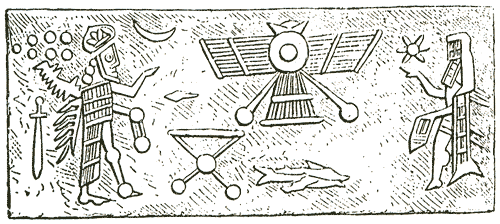
The central object in this ancient drawing simulates the, symbol of
the Twelfth Planet, the Winged Globe.
Yet it x looks different: It
is more mechanical, more manufactured than natural. Its "wings" look
almost exactly like the solar panels with which American spacecraft
are provided to convert the Sun's energy to electricity. The two
antennas cannot be mistaken.
The circular craft, with its crownlike top and extended wings and
antennas, is located in the heavens, between Mars (the six-pointed
star) and Earth and its Moon. On Earth, a deity extends his hand in
greeting to an astronaut still out in the heavens, near Mars.
The
astronaut is shown wearing a helmet with a visor and a breastplate.
The lower part of his suit is like that of a "fish-man" - a
requirement, perhaps, in case of an emergency splashdown in the
ocean. In one hand he holds an instrument; the other hand
reciprocates the greeting from Earth.
And then, cruising on, there was Earth, the seventh planet. In the
lists of the "Seven Celestial Gods" it was called SHU.GI ("right
resting place of SHU"). It also meant the "land at the conclusion of
SHU," of the Supreme Part of the solar system - the destination of
the long space journey.
While in the ancient Near East the sound gi was sometimes
transformed into the more familiar ki ("Earth," "dry land"), the
pronunciation and syllable gi have endured into our own times in
their original meaning, exactly as the Nefilim meant it to be: geo-graphy,
geo-metry, geo-logy.
In the earliest form of pictographic writing, the sign SHU.GI also
meant shibu ("the seventh"). And the astronomical texts explained:
Shar shadi il Enlil ana kakkab SHU.GI ikabbi
"Lord of Mountains, deity Enlil, with planet Shugi is identical."
Paralleling the seven stations of Marduk's journey, the planets'
names also bespeak a space flight.
The land at the journey's end was
the seventh planet, Earth.
We may never know whether, countless years from now, someone on
another planet will find and understand the message drawn on the
plaque attached to Pioneer 10. Likewise, one would think it futile
to expect to find on Earth such a plaque in reverse - a plaque
conveying to Earthlings information regarding the location and the
route from the Twelfth Planet.
Yet such extraordinary evidence does exist.
The evidence is a clay tablet found in the ruins of the Royal
Library in Nineveh. Like many of the other tablets, it is
undoubtedly an Assyrian copy of an earlier Sumerian tablet. Unlike
others, it is a circular disc; and though some cuneiform signs on it
are excellently preserved, the few scholars who took on the task of
deciphering the tablet ended by calling it "the most puzzling
Mesopotamian document."
In 1912, L. W. King, then curator of Assyrian and Babylonian
antiquities in the British Museum, made a meticulous copy of the
disc, which is divided into eight segments.
The undamaged portions bear geometric shapes unseen on any other
ancient artifact, designed and drawn with considerable precision.
They include arrows, triangles, intersecting lines, and even an
ellipse - a geometric-mathematical curve previously assumed to have
been unknown in ancient times.
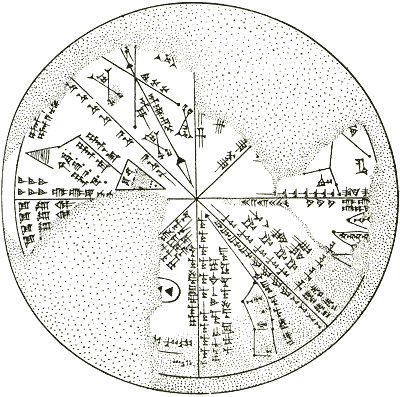
The unusual and puzzling clay plaque was first brought to the
attention of the scientific community in a report submitted to the
British Royal Astronomical Society on January 9, 1880.
R. H. M. Bosanquet and A. H. Sayce, in one of the earliest discourses on "The
Babylonian Astronomy," referred to it as a planisphere (the
reproduction of a spherical surface as a flat map). They announced
that some of the cuneiform signs on it "suggest measurements appear
to bear some technical meaning."
The many names of celestial bodies appearing in the eight segments
of the plaque clearly established its astronomical character.
Bosanquet and Sayce were especially intrigued by the seven "dots" in
one segment. They said these might represent the phases of the Moon,
were it not for the fact that the dots appeared to run along a line
naming the "star of stars" DIL.GAN and a celestial body called APIN.
"There can be no doubt that this enigmatical figure is susceptible
of a simple explanation," they said. But their own effort to provide
such an explanation did not go beyond reading correctly the phonetic
values of the cuneiform signs and the conclusion that the disc was a
celestial planisphere.
When the Royal Astronomical Society published a sketch of the
planisphere, J. Oppert and P. Jensen improved the reading of some
star or planet names. Dr. Fritz Hommel, writing in a German magazine
in 1891 ("Die Astronomic iler Alten Chaldaer"), drew attention to
the fact that each one of the eight segments of the planisphere
formed an angle of 45 degrees, from which he concluded that a total
sweep of the skies - all 360 degrees of the heavens - was
represented. He suggested that the focal point marked some location
"in the Babylonian skies."
There the matter rested until Ernst F. Weidner, first in un article
published in 1912 (Babyloniaca: "Zur Baby-lonischen Astronomic") and
then in his major textbook Handbuch der Babylonischen Astronomie
(1915), thoroughly analyzed the tablet, only to conclude that it did
not make sense.
His bafflement was caused by the fact that while the geometric
shapes and the names of stars or planets written within the various
segments were legible or intelligible (even if their meaning or
purpose was unclear), the inscriptions along the lines (running at
45-degree angles to each other) just did not make sense.
They were,
invariably, a series of repeated syllables in the tablet's Assyrian
language.
They ran, for example, thus:
lu bur di lu bur di lu bur di
bat bat bat kash kash kash kash alu alu alu alu
Weidner concluded that the plaque was both astronomical and
astrological, used as a magical tablet for exorcism, like several
other texts consisting of repeated syllables. With this, he laid to
rest any further interest in the unique tablet.
But the tablet's inscriptions assume a completely different aspect
if we try to read them not as Assyrian word-signs, but as Sumerian
word-syllables; for there can hardly be any doubt that the tablet
represents an Assyrian copy of an earlier Sumerian original.
When we
look at one of the segments (which we can number I), its meaningless syllables,
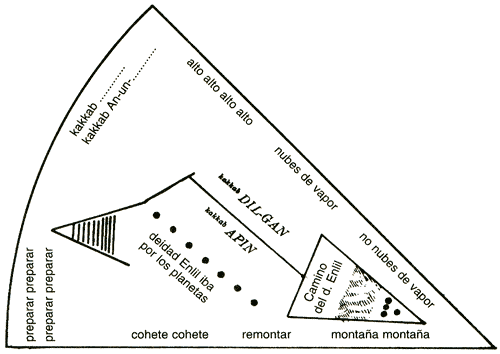
na nanana ana ananu (along the descending line) aha sha sha sha sha
sha (along the circumference) sham sham bur bur Kur (along the
horizontal line),
...literally spring to meaningfulness if we enter the Sumerian meaning
of these word-syllables.
What unfolds here is a route map, marking the way by which the god
Enlil "went by the planets," accompanied by some operating
instructions.
The line inclined at 45 degrees appears to indicate
the line of a spaceship's descent from a point which is "high high
high high," through "vapor clouds" and a lower zone that is vaporless, toward the horizon point, where the skies and the ground
meet.
In the skies near the horizontal line, the instructions to the
astronauts make sense: They are told to "set set set" their
instruments for the final approach; then, as they near the ground,
"rockets rockets" are fired to slow the craft, which apparently
should be raised ("piled up") before reaching the landing point
because it has to pass over high or rugged terrain ("mountain
mountain").
The information provided in this segment clearly pertains to a space
voyage by Enlil himself. In this first segment we are given a
precise geometric sketch of two triangles connected by a line that
turns at an angle. The line represents a route, for the inscription
clearly states that the sketch shows how the "deity Enlil went by
the planets."
The starting point is the triangle on the left, representing the
farther reaches of the solar system; the target area is on the
right, where all the segments converge toward the landing point.
The triangle on the left, drawn with its base open, is akin to a
known sign in Near Eastern pictographic writing; its meaning can be
read as "the ruler's domain, the mountainous land." The triangle on
the right is identified by the inscription shu-ut il Enlil ("Way of
god Enlil"); the term, as we know, denotes Earths northern skies.
The angled line, then, connects what we believe to have been the
Twelfth Planet - "the ruler's domain, the mountainous land" - with
Earth's skies. The route passes between two celestial bodies -
Dilgan and Apin.
Some scholars have maintained that these were names of distant stars
or parts of constellations. If modern manned and unmanned spacecraft
navigate by obtaining a "fix" on predetermined bright stars, a
similar navigational technique for the Nefilim cannot be ruled out.
Yet the notion that the two names stand for such faraway stars
somehow does not agree with the meaning of their names: DIL.GAN
meant, literally, "the first station"; and APIN, "where the right
course is set."
The meanings of the names indicate way stations, points passed by.
We tend to agree with such authorities as Thompson, Epping, and
Strassmaier, who identified Apin as the planet Mars. If so, the
meaning of the sketch becomes clear: The route between the Planet of
Kingship and the skies above Earth passed between Jupiter ("the
first station") and Mars ("where the right course is set").
This terminology, by which the descriptive names of the planets were
related to their role in the space voyage of (he Nefilim, conforms
with the names and epithets in the lists of the Seven Shu Planets.
As if to confirm our conclusions, the inscription stating that this
was the route of Enlil appears below a row of seven dots - the Seven
Planets that stretch from Pluto to Earth.
Not surprisingly, the remaining four celestial bodies, those in the
"zone of confusion," are shown separately, beyond Earth's northern
skies and the celestial band.
Evidence that this is a space map and flight manual shows up in all
the other undamaged segments, too.
Continuing in a counterclockwise
direction, the legible portion of the next segment bears the
inscription: "take take take cast cast cast cast complete complete."
The third segment, where a portion of the unusual elliptical shape
is seen, the legible inscriptions include "kakkab SIB.ZI.AN.NA...
envoy of AN.NA... deity ISH.TAR," and the intriguing sentence:
"Deity NI.NI supervisor of descent."
In the fourth segment, which contains what appear to be directions
on how to establish one's destination according to a certain group
of stars, the descending line is specifically identified as the
skyline: The word sky is repeated eleven times under the line.
Does this segment represent a flight phase nearer Earth, nearer the
landing spot? This might indeed be the import of the legend over the
horizontal line:
"hills hills hills hills top top top top city city
city city."
The inscription in the center says:
"kakkab MASH.TAB.BA
[Gemini] whose encounter is fixed: kakkab SIB.ZI.AN.NA [Jupiter]
provides knowledge."
If, as appears to be the case, the segments are arranged in an
approach sequence, then one can almost share the excitement of the
Nefilim as they approached Earth's spaceport. The next segment,
again identifying the descending line as "sky sky sky," also
announces:
our light our light our light change change change change observe
path and high ground ... flat land . . .
The horizontal line contains, for the first time, figures:
rocket rocket
rocket rise glide 40 40 40
40 40 20 22 22
The upper line of the next segment no longer states: "sky sky";
instead, it calls for "channel channel 100 100 100 100 100 100 100."
A pattern is discernible in this largely damaged segment. Along one
of the lines the inscription says:
"Ashshur," which can mean "He who
sees" or "seeing."
The seventh segment is too damaged to add to our examination; the
few discernible syllables mean "distant distant . . . sight sight,"
and the instructional words are "press down." The eighth and final
segment, however, is almost complete. Directional lines, arrows, and
inscriptions mark a path between two planets. Instructions to "pile
up mountain mountain," show four sets of crosses, inscribed twice
"fuel water grain" and twice "vapor water grain."
Was this a segment dealing with preparations for the flight toward
Earth, or one dealing with stocking up for the return flight to
rejoin the Twelfth Planet?
The latter may have been the case, for
the line with the sharp arrow pointing toward the landing site on
Earth has at its other end another "arrow" pointing in the opposite
direction, and bearing the legend "Return."
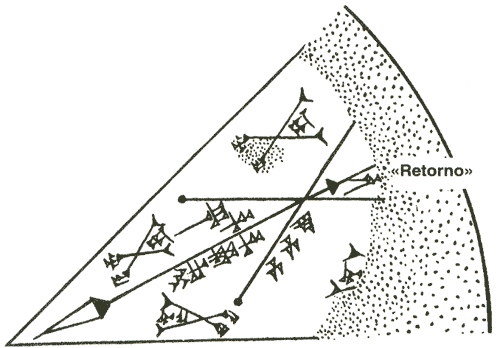
When Ea arranged for Anu's emissary to "make Adapa take the road to
Heaven" and Anu discovered the ruse, lie demanded to know:
Why did Ea, to a worthless human
the plan of Heaven-Earth disclose –
rendering him distinguished,
making a Shem for him?
In the planisphere we have just deciphered, we indeed ice such a
route map, a "plan of Heaven-Earth." In sign language and in words,
the Nefilim have sketched for us the route from their planet to
ours.
Otherwise inexplicable texts dealing with celestial distances also
make sense if we read them in terms of space travel from the Twelfth
Planet. One such text, found in the ruins of Nippur and believed to
be some 4,000 years old, is now kept at the Hilprecht Collection at
the University of Jena, in Germany.
O. Neugebauer (The Exact
Sciences in Antiquity) established that the tablet was undoubtedly a
copy "from an original composition which was older"; it gives ratios
of celestial distances starting from the Moon to Earth and then
through space to six other planets.
The second part of the text appears to have provided the
mathematical formulas for solving whatever the interplanetary
problem was, stating (according to some readings):
40420640 X 9 is 6 40
13 kasbu 10 ush mul SHU.PA
eli mul GIR sud
40 4 20 6 40 X 7 is 5 11 6 40
10 kasbu 11 ush 6'/2 gar 2 u mul GIR tab
eli mul SHU.PA sud
There has never been full agreement among scholars as to the correct
reading of the measurement units in this part of the text (a new
reading was suggested to us in a letter from Dr. J. Oelsner,
custodian of the Hilprecht Collection at Jena).
It is clear,
however, that the second part of the text measured distances from SHU.PA (Pluto).
Only the Nefilim, traversing the planetary orbits, could have worked
out these formulas; only they needed such data..
Taking into consideration that their own planet and their target,
Earth, were both in continuous motion, the Nefilim had to aim their
craft not at where Earth was at launch time but where it would be at
arrival time. One can safely assume that the Nefilim worked out
their trajectories very much as modern scientists map the missions
to the Moon and to other planets.
The spacecraft of the Nefilim was probably launched from the Twelfth
Planet in the direction of the Twelfth Planet's own orbit, but well
ahead of its arrival in Earth's vicinity. Based on these and a
myriad other factors, two alternative trajectories for the
spacecraft were worked out for us by Amnon Sitchin, doctor of
aeronautics and engineering.
The first trajectory would call for the
launching of the spacecraft from the Twelfth Planet before it
reached its apogee (the point farthest out). With few power needs,
the spaceship would actually not so much change course as slow down.
While the Twelfth Planet (a space vehicle, too, even though a huge
one) continued on its vast elliptical orbit, the spaceship would
follow a much shorter elliptical course and reach Earth far ahead of
the Twelfth Planet.
This alternative may have offered the Nefilim
both advantages and disadvantages.
The full span of 3,600 Earth years, which applied to tenures of
office and other activities of the Nefilim upon Earth, suggests that
they might have preferred the second alternative, that of a short
trip and a stay in Earth's skies coinciding with the arrival of the
Twelfth Planet itself. This would have called for the launching of
the spaceship (C) when the Twelfth Planet was about midway on its
course back from the apogee.
With the planet's own speed rapidly
increasing, the spaceship required strong engines to overtake its
home planet and reach Earth (D) a few Earth years ahead of the
Twelfth Planet.
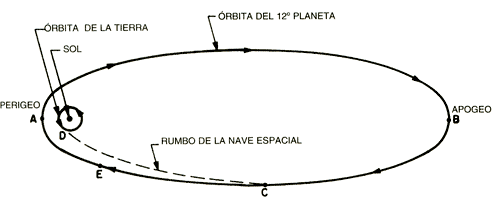
Based on complex technical data, as well as hints in Mesopotamian
texts, it appears that the Nefilim adopted for their Earth missions
the same approach NASA adopted for the Moon missions: When the
principal spaceship neared the target planet (Earth), it went into
orbit around that planet without actually landing.
Instead, a
smaller craft was released from the mother ship and performed the
actual landing.
As difficult as accurate landings were, the departures from Earth
must have been even trickier. The landing craft had to rejoin its
mother ship, which then had to fire up its engines and accelerate to
extremely high speeds, for it had to catch up with the Twelfth
Planet, which by then was passing its perigee between Mars and
Jupiter at its top orbital speed.
Dr. Sitchin has calculated that
there were three points in the spaceship's orbit of Earth that lent
themselves to a thrust toward the Twelfth Planet. The three
alternatives offered the Nefilim a choice of catching up with the
Twelfth Planet within 1.1 to 1.6 Earth years.
Suitable terrain, guidance from Earth, and perfect coordination with
the home planet were required for successful arrivals, landings,
takeoffs, and departures from Earth.
As we shall see, the Nefilim met all these requirements.
Return to Contents
|









